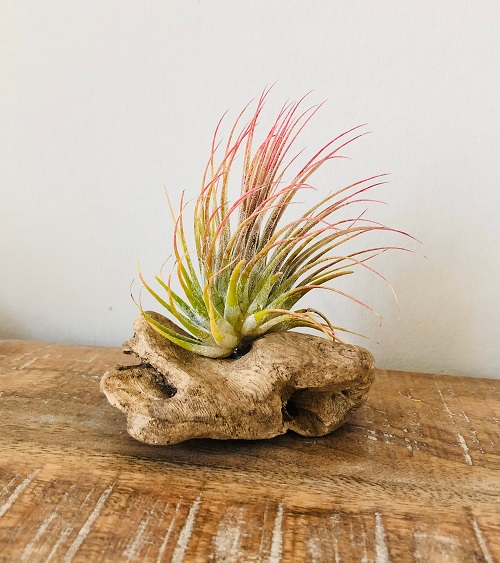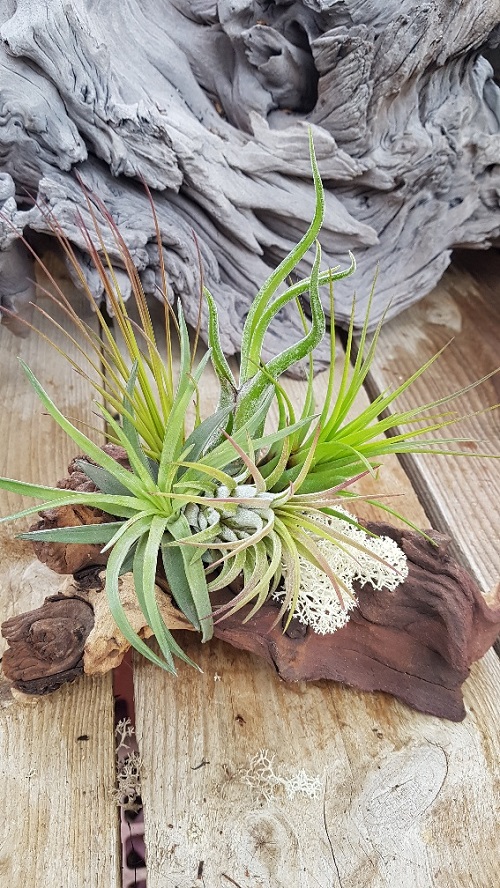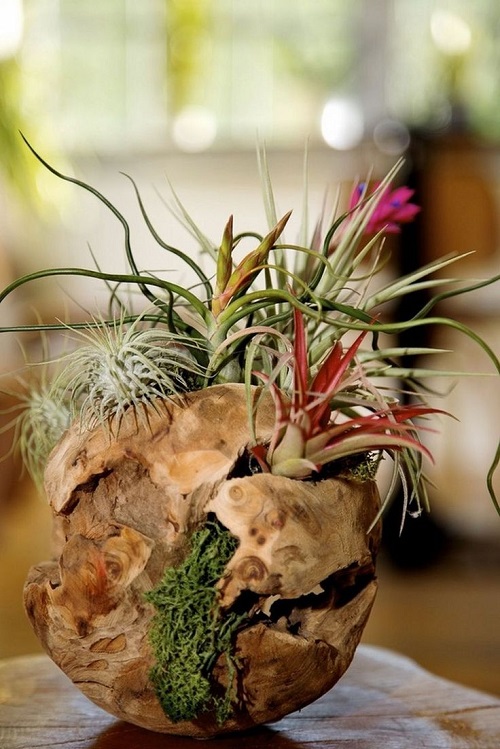Learn How to Attach Air Plants to Wood with this step-by-step guide and elevate your decor with these low-maintenance beauties.
Integrating air plants into your home or office decor can infuse a breath of fresh, vibrant life into your surroundings. These unique plants, known for their minimalistic care requirements, can be attached to various surfaces for a stunning display. One popular and visually striking option is to affix air plants to wood, creating an eye-catching fusion of nature and design that captures the imagination. Let’s explore How to Attach Air Plants to Wood and transform ordinary pieces of timber into captivating living artworks.
Want to Know Harrisii Air Plant Care Guide, Read here
Air Plants Information
Air plants are unique members of the Bromeliaceae family. These plants are epiphytes, which means they grow attached to other surfaces like trees and rocks. Unlike typical plants, they do not require soil to thrive. Instead, they anchor themselves to their host surfaces using specialized structures called trichomes.
There are over 650 different species of air plants, each with its own unique size, shape, and color. They vary in size, with some as small as a few inches and others reaching up to 12 inches or more. Due to their unique growth habits, air plants can be displayed creatively. They are often mounted on objects like wood, rocks, or in decorative containers.
Explore Air Plant Juncea Care here
How to Attach Air Plants to Wood
1. Using Adhesive or Glue:
- Ensure the wood surface is clean and dry.
- Dab a small amount of adhesive or glue on the back of the air plant’s base.
- Press the air plant firmly onto the wood surface.
- Hold it in place for a few minutes until the glue sets.
- Allow the glue to fully dry before moving or watering the plant.
- Using adhesive to attach air plants to wood is a secure and easy method that ensures the plants stay in place, making it ideal for creating long-lasting decorative displays.
2. Wiring the Air Plants:
- Cut a piece of wire to the desired length.
- Gently wrap the wire around the base of the air plant.
- Position the plant on the wood and twist the wire to secure it.
- Trim any excess wire.
- Adjust the angle of the plant for the desired look.
- Wiring air plants to wood offers flexibility in arranging and repositioning the plants as needed, making it a versatile and creative display option.
3. Using Hooks or Nails:
- Install small hooks or nails onto the wood, leaving enough space for the air plant.
- Hang the air plant by gently looping its base over the hook or nail.
- Ensure the plant is secure and doesn’t fall off.
- This method is perfect for creating an attractive hanging air plant arrangement on wood, adding a touch of elegance to your décor.
4. Drilling Holes for Plant Placement:
- Choose the locations for the air plants and mark them on the wood.
- Use a drill slightly larger than the air plant’s base to create holes.
- Insert the air plants into the holes, ensuring they fit snugly.
- Drilling holes for air plants provides a neat and organized way to display them on wood, making it easy to arrange them in artistic patterns.
5. Using Plant Wire or Twine:
- Cut a piece of plant wire or twine to the desired length.
- Gently wrap it around the base of the air plant.
- Secure the wire or twine to the wood with a knot or by tucking it under other fasteners.
- Adjust the tension to ensure the air plant is stable.
- Using plant wire or twine offers a natural and rustic look when attaching air plants to wood, making it suitable for various decorative styles.
Read About Air Plant Care here
Tips To Attach Your Air-Plants to Wood
1. Choose Suitable Attachment Surfaces:
Before attaching your air plants, select appropriate surfaces that complement both the plant’s aesthetic and your décor. Wood, cork, rocks, or decorative containers are popular choices. Ensure the chosen surface is clean and free from dust or debris. The surface should also be compatible with the attachment method.
2. Use Plant-Safe Adhesive:
If you opt for adhesive to attach air plants, ensure it is non-toxic and safe for plants. Many craft glues or specialized plant adhesives are available. Apply a small amount of adhesive to the base of the air plant, taking care not to cover the trichomes. Press the plant onto the chosen surface until the adhesive sets, typically a few minutes. Allow the adhesive to dry completely before moving or watering the plant.
3. Consider Wire or Twine Wrapping:
Wrapping the air plant’s base with wire or twine is a flexible and secure method. It’s especially useful for hanging air plants. Gently wrap a piece of thin, flexible wire or twine around the base of the air plant. Position the plant on the surface and secure it by twisting the wire or twine.
4. Create Holes for Placement:
For a clean and organized display, you can drill small holes in the attachment surface to securely hold air plants. Mark the locations of the air plants on the surface. Use a drill slightly larger than the air plant’s base to create holes. Insert the air plants into the holes, making sure they fit snugly. This method allows you to arrange air plants in artistic patterns on wood or other surfaces.
5. Ensure Adequate Air Circulation:
Air plants thrive on good air circulation. When attaching them to surfaces, ensure enough airflow around the plant. Avoid overcrowding air plants in a tight space. Leave some space between individual plants to allow for proper ventilation. Adequate air circulation helps prevent moisture buildup, which can lead to root rot.
6. Monitor Light and Water Needs:
Different air plant species have varying light and water requirements. Consider the placement of your attached air plants to ensure they receive the right amount of light and moisture. Research the specific needs of your air plant species and place them accordingly. Typically, air plants thrive in bright, indirect light and require occasional misting or soaking, depending on the species.
Read About Do All Air Plants Bloom here
Frequently Asked Questions- How to Attach Air Plants to Wood
Q. Can I attach air plants to any type of wood?
While you can attach air plants to various types of wood, it’s essential to choose a wood that complements your aesthetic and is clean, dry, and free from chemicals or preservatives. Popular options include driftwood, cedar, and reclaimed wood. Avoid woods that may release harmful substances.
Q. What is the best way to attach air plants to wood securely?
The best method depends on your preference and the type of wood. Common attachment methods include using plant-safe adhesive, wiring, hooks or nails, drilling holes, or wrapping with plant wire or twine. Choose a method that suits your design and ensures the air plant stays in place.
Q. Is it necessary to prepare the wood surface before attaching air plants?
Yes, preparing the wood surface is crucial. Ensure it’s clean, dry, and free from dust or debris. If the wood has rough surfaces or splinters, sanding it lightly can help prevent damage to the air plant leaves.
Q. Can I move or rearrange air plants attached to wood once they are in place?
Yes, you can move or rearrange air plants attached to wood. Depending on the attachment method, you may need to remove and reattach them carefully. Wiring and hooks/nails allow more flexibility in rearranging your air plants.
Q. Can I attach multiple air plants to the same piece of wood?
Yes, you can attach multiple air plants to the same piece of wood. Ensure they have adequate space for air circulation to prevent moisture buildup and rot. Consider arranging them in an aesthetically pleasing pattern.
Q. How can I incorporate air plants attached to wood into my home decor?
Air plants on wood can be used in various ways. They make excellent wall art, centerpieces, or even hanging displays. Get creative by arranging them with other decorative elements to enhance your decor’s aesthetic.
Explore the Amazing Benefits of Air Plants here




